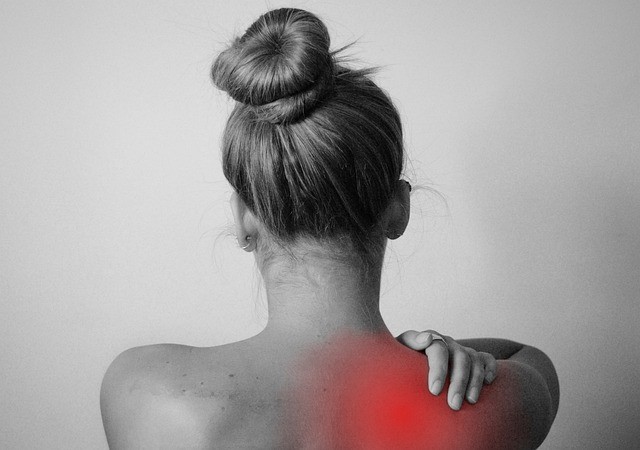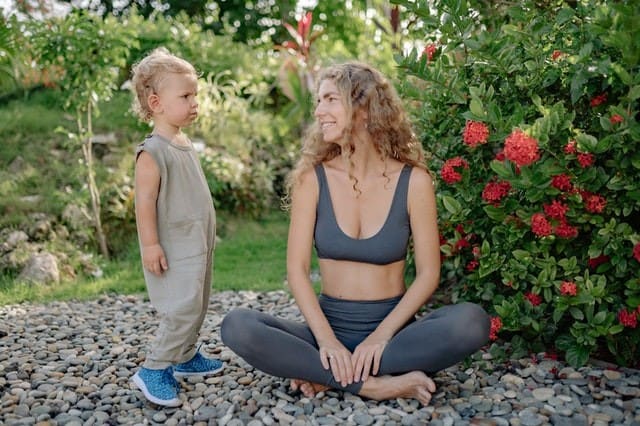Breastfeeding offers extensive nutritional and psychological health benefits to both moms and babies. However, despite the huge benefits of breastfeeding, it can also come with challenges. For one, this sweet mom-and-baby bonding may take a toll on your back, which can result in pain.
Back pain while breastfeeding is a fairly common experience. It can be due to left-over back pain from pregnancy and childbirth. But more often, it is caused by hunching over to find the perfect breastfeeding position. While this might not be completely unavoidable, identifying its cause and taking corrective measures can help relieve back pain.
If you are experiencing back pain and it is making breastfeeding more difficult, then this post is for you. Read on to find out the causes of back pain while breastfeeding, how you can get relief from this pain, and what you can do to prevent it from happening again.
What Causes Back Pain While Breastfeeding?
Breast milk offers optimal nutrition for your baby’s growth and development. Breastfeeding, however, may not always be easy.
Since breast milk can be easily digested, moms need to breastfeed about 8 to 12 times per day during the first two to four weeks. This means women find themselves sitting for hours while holding the baby for feedings daily. Hence, a lot of mothers are struggling with back pain from breastfeeding.
Below are some of the culprits behind the back pain a mom may experience while breastfeeding:
-
Poor Breastfeeding Posture
Back pain while breastfeeding is commonly attributed to poor breastfeeding positions. When it comes to alleviating back pain, posture is key, so it is crucial to be mindful of your position. Breastfeeding in a slouched position puts stress on your spine and back muscles resulting in back pain.
-
Left-Over Back Pain from Pregnancy and Labor
During pregnancy, the body releases a hormone called relaxin in preparation for the birth process. This hormone allows the ligaments in the pelvic area to relax and the joints to loosen.
The same hormone is responsible for relaxing and loosening the muscles and ligaments that support the spine, leading to instability and pain. If you were already dealing with back pain during pregnancy, it can continue even after delivery and especially when you are nursing your baby.
-
Postpartum Weight Gain
Weight gain post-pregnancy may trigger back pain, particularly if your breasts have become relatively heavy for your frame.
-
Awkward Lifting Position
Lifting heavy weights may aggravate backaches, and carrying a baby for hours daily can be a trigger. When lifting your baby, make every effort to keep your back straight, feet hip-width apart, and bend with your knees, not your back.
-
Lack of Sleep
Sleep deprivation may result in stress and tension, thus straining the back muscles, which can lead to increased back and neck pain.
Tips to Avoid Back Pain While Breastfeeding
On average, each nursing session can last anywhere from 10 to 45 minutes —that means moms are spending a great portion of the day sitting.
The following tips will help you take care of your back while you are nursing your baby. If you are not struggling with back pain now, you can ensure that it does not become an issue later on.
Pick the Right Chair
Picking a supportive chair to sit on while nursing can make a huge difference, both in helping you breastfeed comfortably and avoiding back pain. Sitting on a deep, soft chair that allows you to ‘sink in’ can cause you to slouch in an awkward position. You should opt for a comfortable but firm chair that can provide better support for your back.
Lumbar Support
Lumbar support is key for protecting your back while you are breastfeeding. Having a little stool so that your feet are supported, and not dangling or barely touching the ground, would also be a great help for nursing comfortably.
Switch Up Positions
The same repetitive position can cause a strain on the back muscles. For this reason, switching positions when breastfeeding is recommended. Try mixing up positions when nursing your little one. This can mean nursing in a baby wrap or carrier, in a reclined position, or while lying down. In the same way, taking movement breaks in between feedings can make a big difference to avoid the backaches associated with breastfeeding.
Consider using a baby wrap
Yes, nursing while baby-wearing is not only for times when you are on the move! There are wonderful options for baby wraps that you can use while nursing to hold your little one in position, and share the burden of weight from your back. Nursing with your baby in a sling, wrap, or soft-structured carrier, while you are standing, is an excellent way to give your back a break from prolonged sitting.
Get Moving
After giving birth, women need approximately six weeks for their bodies to heal and recover. With your doctor’s permission, you can start doing some light exercises to help strengthen your body. Exercise strengthens your core and stabilizes your lower back while encouraging movement at your shoulders and mid-back.
Take a Walk
Enjoy a good walk outside and get some fresh air. Walking is an effective exercise to help strengthen your back muscles. Investing time to go out and walk can help manage backaches and pains.
Manage Your Stress
The early months of motherhood can be particularly challenging as it is exhausting. The extra tension from stress can trigger strain in your muscles, resulting in back, neck, and shoulder pain. Take some time out and find some ways you can cope with stress. Treat yourself to a massage, a warm shower, or listen to relaxing music.
7 Ways to Relieve Back Pain While Breastfeeding
Below are tips on what you can do if you experience back pain while breastfeeding:
-
Be mindful of your breastfeeding position
Your breastfeeding position plays a crucial role in managing back pain. Sit with your back supported and upright to protect the lower back and keep your shoulder blades together as much as possible. Make sure that you are not slouching or hunching over to reach your baby. Always bring your baby to you, instead of bringing your breast to your baby.
Without proper posture, you are putting yourself in a position that puts unnecessary stress on your body every time you nurse your baby. The longer it takes you to correct the habit, the longer you can be prone to experiencing back pains — even after you stop breastfeeding.
-
Use pillows for support
A nursing pillow can be your life saver to help you nurse comfortably. Some moms swear by a nursing stool to keep their feet and legs supported while breastfeeding.
-
Make sure you are well-hydrated
Breast milk contains about 88% water. Proper hydration keeps your spinal discs, which rely on water to keep bones from rubbing together, plump, and keep your back pain at bay. As a busy mom, you may find yourself ignoring your thirst, particularly if there is nothing nearby to drink. Try to keep your drinking bottle within reach or on a spot where you usually breastfeed your baby.
-
Use hot compress
A hot compress for 15 to 20 minutes at a time may help alleviate upper and lower back pain. Use a heating pad to relieve the pain and relax the muscles on the sore parts of your back, shoulders, or neck while you are breastfeeding.
-
Stretch it out!
Take brief breaks in between feedings. Do some stretching to help reduce the strain that may build up in your body from staying in the same position for prolonged periods while nursing.
-
Get a massage
A relaxing back massage is a great way to loosen those strained muscles and make you feel more relaxed and calm.
-
Get enough rest
While getting enough night’s rest may seem like an impossible task especially if you are caring for a newborn, adequate rest and sleep are essential for moms who have just recently given birth. Try to sneak some sleep or at least rest when the baby sleeps. A well-rested body is essential for recovery and prevents aggravated backaches. Enlist help from other family members for the household chores while you take some much-needed rest.
Many moms do not expect the aches and pains that come with breastfeeding, that is, on top of the exhaustion that comes with caring for a baby. If you have chronic pain, or you feel that your back pain is not settling or improving even if you have tried different measures to relieve it, do not hesitate to seek medical help.
Exercises to Relieve Back Pain from Breastfeeding
There are plenty of great benefits from breastfeeding, but having back pain is certainly not one of them. Fortunately, there are a number of exercises that can help loosen up your back and strengthen the core muscles that stabilize your spine.
Stretching exercises can bring motion and blood flow into the back to combat tension and stiffness. If you are medically cleared to do some exercises, check out the following exercises you might want to try doing at home to fight back pain while breastfeeding:
Child’s Pose Arm Stretch
A great exercise for back pain relief, the child’s pose stretches your lower back and arms, relaxing your body. In the arm-stretched child’s pose, you reach your arms forward with palms facing down in a relaxed position along the floor, resting your stomach comfortably on top of your thighs, and allowing your forehead to come to the floor. Hold up for about a minute or longer while taking deep breaths.
Cat-Cow Pose
Get on the floor on all fours, wrists directly under your shoulders while keeping your knees under your hips. Gently arch your back as you exhale, tucking your tail bone and head inwards. Slowly move your spine toward the opposite direction, while inhaling and looking up to the ceiling, curving the lower spine. Repeat the pattern about ten times gently and slowly.
Neck Stretch
Position your right arm behind your back and gently look to your left. Continue to look left and then down gently. Hold for about a minute and repeat, this time with the left arm behind your back and turn and look to the right and down. Hold this stretch for about a minute. Repeating the neck stretch a couple of times throughout the day can help prevent neck and upper back tightness.
Towel Stretch
Stand up with feet hip-width apart. Hold a towel extending further than shoulder-distance apart. Inhale with your arms above you and exhale with your arms down in front of you. Then, inhale with your arms up above your head. While exhaling, bring your arms behind you. Get your hands in front as you inhale up and exhale down. Repeat for a few times. Remember to inhale with your nose, and breathe out the tension and stress out through your mouth.
Doorway Stretch
Standing in an open doorway, place your elbows on each side of the doorway with your forearms and palms flat on the wall. Step forward with your right foot. Feel the stretch as you press your chest through the door. Take deep breaths into your chest and lungs. Breathe out, allowing your shoulders and chest to relax and loosen up.
Breastfeeding Positions to Avoid Back Pain
In most cases, the nursing mom tends to lean towards the baby, instead of bringing the baby closer to her. Thus, the mom will have the tendency to slouch and crane her neck towards the baby.
Sustained craning of the neck lengthens, and puts unnecessary pressure on, the neck and back muscles. Over time, this strain accumulates, leading to soreness and tightness over your neck and upper back.
Here are some breastfeeding positions you can try to alleviate, as well as prevent, back pain while breastfeeding:
Cradle Position
This is the classic nursing position and involves the mother sitting upright, with the baby positioned on her side. The baby’s head and neck are placed along the mother’s forearm with the baby’s body against the mother’s stomach (tummy-to-mummy position).
To provide more support, you can use a pillow or cushion behind your back. You can also put a nursing pillow across your lap to prop up your baby and avoid straining your back and shoulders.
Cross-Cradle Position
For many moms, this is the preferred breastfeeding position. It allows mothers to easily view their baby and see his latching. It is also an easy position for mothers to learn.
In the cross-cradle position, the baby lies across their mother’s body. If the baby is nursing on the left breast, the right arm is used to support the baby around his neck and shoulders, while the breast is supported with the left hand.
Laid-Back or Reclined Position
Also known as biological nurturing, laid-back breastfeeding taps into the baby’s natural reflexes to nurse himself. When you lay back or recline while nursing your baby, you relax your neck and back muscles, making your body less rigid and tense.
This position also allows for more skin-to-skin contact while nursing. Use cushions or pillows so you can gaze at your baby and to provide you enhanced support.
Side-Lying Position
Side-lying lets you breastfeed without the need to support yourself or your baby. This position works especially well for mothers who have had a cesarean section or stitches.
Lay your little one next to you, with his nose in line with your nipple. With this position, you can even sneak some shut-eye while you are feeding your baby.
Upright Position
Once your baby learns how to sit up, use that to your advantage. Also called the koala hold, this position takes stress off your back. Here your little one sits facing you in a straddling position on your thigh or hip, with his spine and head upright while he feeds.
Standing Position
While it may sound odd, nursing while standing is a great way to take the pressure off your back. Use a sling or baby carrier to support your baby’s weight. This position is also useful for babies who are reluctant to nurse because of reflux. The gentle movements while walking can help calm your baby and encourage him to nurse.
The Football Hold
This is also sometimes called a clutch hold. In this nursing position, your baby is tucked under your arm, off to the side. The baby is held with one arm while you support your breast with your other arm.
So when you are holding your baby on the right side, he will latch into your right breast while you support that breast using your left hand.
Final Words
At some point, every mom will face some strain on her back when breastfeeding, especially without an optimal posture. A proper nursing position can mean the difference for moms struggling to find relief from back pain.
Experiment with different positions and find the one that works best for you and your baby. It is crucial to start implementing the right position and techniques as soon as possible after birth, as this will safeguard your body from the aches and pains associated with breastfeeding.










